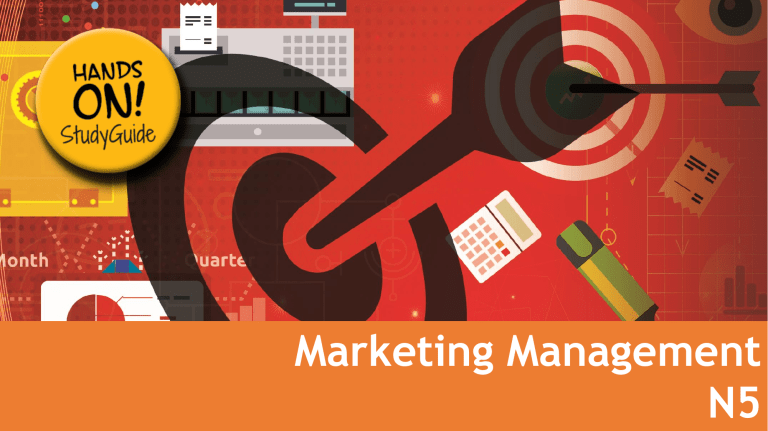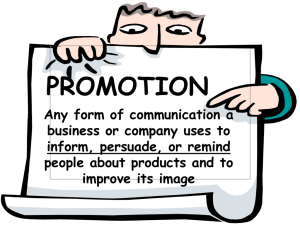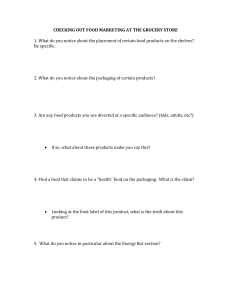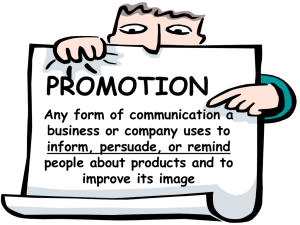
Marketing Management N5 Module 1: Product and service policy THE NATURE OF PRODUCT POLICY The product serves as the “heart” of the organisation. It is important to note that all marketing activities start with the product. A product consists of a collection of tangible (visible) problem-solving, need-satisfying attributes, which is made available to the market (users) in order to get the market to pay attention to it, buy it and use it. www.futuremanagers.com Module 1: Product and service policy (continued) CLASSIFICATION OF PRODUCTS AND SERVICES For the purpose of marketing management, products are divided into homogeneous groups using certain criteria. The three main groups are: • Consumer products. • Industrial products. • Services. www.futuremanagers.com Module 1: Product and service policy (continued) THE DEVELOPMENT OF NEW PRODUCTS AND SERVICES Products move through a life cycle. This causes a constant demand for new products. Rapid changes in the marketing environment lead to shorter product life cycles – especially consumer products. Constant development and marketing of new products have become indispensable to the growth and progress of any business. www.futuremanagers.com Module 1: Product and service policy (continued) THE PRODUCT LIFE CYCLE www.futuremanagers.com Module 1: Product and service policy (continued) PRODUCT STRATEGIES A product strategy can be described as the purposeful and objective decisions of management to adjust the product range timeously, economically and efficiently to the present marketing environment and expected changes in it. www.futuremanagers.com Module 1: Product and service policy (continued) BRANDING Brands are that part of the product decisions that are specifically involved with the identification and distinction of product items and product lines in the product range. Manufacturers and even middlemen attempt to differentiate and to distinguish their products from other competitive products by means of brands. Brand and packaging decisions are very important and are subsections of product decisions. www.futuremanagers.com Module 1: Product and service policy (continued) PACKAGING AND LABELLING Packaging also forms part of the product decisions of a business. Packaging is essential for the protection, storage and physical handling of products. Packaging can also be usefully applied in certain marketing considerations like product differentiation, consumer comfort and marketing communication. Labelling plays a major role in packaging and branding. Sometimes, labels are woven onto products, as in the clothing industry. www.futuremanagers.com Module 2: Distribution policy IMPORTANCE OF DISTRIBUTION Distribution can be described as a structure that links a group of individuals or organisations together to facilitate the flow of goods from the stage where the manufacturing process is finished until it reaches the final consumer. The main objective of the distribution policy is to get the product to the consumer. Decisions about distribution channels, particularly those relating to where, when and how to present products to a specific market, are an important, sometimes critical, aspect of the total marketing strategy. www.futuremanagers.com Module 2: Distribution policy (continued) IMPORTANCE OF INTERMEDIARIES IN MARKETING • Intermediaries reduce the number of transactions. • They also perform the following functions: • Transactional functions. • Logistical functions. • Facilitating functions. www.futuremanagers.com Module 2: Distribution policy (continued) DISTRIBUTION CHANNEL SYSTEMS A distribution channel can have the following intermediaries to help channel the product from producer to consumer: • Wholesalers; • Agents; • Retailers; • Industrial distributors; • Government buyers; • Industrial users; and • Brokers; • Mail-order companies. www.futuremanagers.com Module 2: Distribution policy (continued) BEHAVIOUR PATTERNS IN THE DISTRIBUTION CHANNEL Every member in the distribution channel has a specific role to fulfil in a system that has to adhere to certain standards. Every member has a special field where he operates and where he has to execute tasks like purchasing, selling, transportation, storing and communication. The main tasks in the distribution channel can thus be identified as the following: transportation, advertising, storing, recruitment and negotiations with final consumers. www.futuremanagers.com Module 2: Distribution policy (continued) DISTRIBUTION PLANNING Distribution planning is making decisions concerning the setting of distribution objectives, the design and choice of a distribution channel and the methods of physical distribution that are used to execute the necessary marketing activities in the target market. www.futuremanagers.com Module 2: Distribution policy (continued) THE ROLE OF THE WHOLESALER Wholesalers are firms that buy in bulk directly from manufacturers/producers and then sell the goods mainly to retailers. It also happens that consumers sometimes buy from wholesalers. A company can be classified as a wholesaler when the institution earns more than 50% of its gross income from the sales of goods to resellers and other institutions. www.futuremanagers.com Module 2: Distribution policy (continued) THE ROLE OF THE RETAILER To qualify as a retailer, it is necessary that the company earns more than 50% of its gross income from the public or end-user consumer. The nature of service supplied by the retailer can take various forms such as: • Counter service; • Self-selection; • Self-service; and • Direct selling. www.futuremanagers.com Module 2: Distribution policy (continued) PHYSICAL DISTRIBUTION Physical distribution is often referred to as logistics. Physical distribution can be described as the movement, handling and storing of goods after finishing the production process, and the delivering thereof to the final consumer or user. www.futuremanagers.com Module 3: Price policy THE NATURE AND IMPORTANCE OF PRICE IN MARKETING Price can be defined as a value expressed in terms of Rands and cents. Price is, therefore, the value that is attached to products and services and is the amount of money needed to obtain such a product, and the benefit or utility associated with it. www.futuremanagers.com Module 3: Price policy (continued) THE DEVELOPMENT OF A PRICE STRATEGY The following steps are followed when a final price is determined: 1. Analyse the internal and external factors that influence price. 2. Formulate the price objectives. 3. Determine the basic price. 4. Make adjustments to the basic price. 5. Determine the final price. www.futuremanagers.com Module 3: Price policy (continued) FORMULATE THE PRICE OBJECTIVES Price objective Sales volume objectives Status quo objectives Other price objectives Maximise profits Maintain or increase market share Maintain price image Product quality Leadership Target return Maximising sales volume Stabilise prices Continuity and survival Non-price competition Social responsibility Satisfactory profits Reaction to and prevention of competition www.futuremanagers.com Module 3: Price policy (continued) DETERMINATION OF THE BASIC PRICE In order to make a transaction take place, it is necessary that every business determines a price for its products. The approach to this price can be twosided: firstly, the development of a price that aspires to the needs of the consumer, and secondly, the development of a price that meets the profitability targets. www.futuremanagers.com Module 4: Promotion policy THE NATURE AND IMPORTANCE OF A PROMOTION STRATEGY Promotion can be described as any form of communication that is used to inform, to persuade and to remind consumers to buy the product or service sold by a certain enterprise. promotion strategy may also be called the marketing communication strategy. The promotional strategy is a plan for the optimal blend of all the elements of the promotional mix, namely, advertising, publicity, sales promotion and personal selling. www.futuremanagers.com Module 4: Promotion policy (continued) THE COMMUNICATION PROCESS IN MARKETING Communication is a process by which we exchange or share options by using a common set of symbols. To compile an effective marketing communication mix, it is of the utmost importance that the marketer should have a knowledge or background of the communication channels available to reach a target audience. Communication can be divided into two main categories: interpersonal communication and mass communication. www.futuremanagers.com Module 4: Promotion policy (continued) PROMOTIONAL OBJECTIVES Promotion has three general tasks or objectives, namely, to inform the target market, to persuade the target market, and to remind the target market of the product or service. www.futuremanagers.com Module 4: Promotion policy (continued) THE PROMOTION MIX/MARKETING COMMUNICATION MIX Elements of the promotion mix (Promotion mix= Marketing communication mix) Factors that influence the composition of the promotion mix • • • • • • • • • Advertising. Personal selling. Sales promotion. Publicity. www.futuremanagers.com Availability of funds. Nature of the market. Nature of the product. Phase of the product life cycle. Push or pull strategies. Module 4: Promotion policy (continued) ADVERTISING AND ADVERTISING MANAGEMENT Advertising is used to inform, persuade and remind the customer of the organisation’s product offering and where it is available. • It is the conveyance of an impersonal message to a certain target audience. • It is paid for by an identifiable sponsor, whose objective is to promote a need-satisfying product, service or idea. www.futuremanagers.com



